The post describes simple battery charge monitor circuits or battery status circuits. The first design is a 4 LED voltage monitor circuit using the versatile IC LM324. The idea was requested by Ms. Piyali.
Technical Specifications
I've a project, if you could help me out:
1. basically its a battery voltage detector cum indicator circuit.
2. the output from a transformer is 6V, 12V, 24V resp., depending on the supplied input. O/p is A.C.
3. by converting it into D.C. I've to design a circuit which will detect and indicate the voltage o/p by colored LED lamps. Such as,
Blue LED - 6V
Green LED - 12V
Red LED - 24V
4. Circuit should be compact in nature as much as possible.
.
Query:
1. should we be using comparator circuit ?
2. how to detect the diff. voltage levels ?
3. Is relay required ?
.
Please consider at earliest.
1) The Design
The proposed battery voltage status monitor circuit using 4 LEDs makes use of comparators in the form of opamps from the IC LM324.
This IC is much versatile than the other opamp counterparts due to its higher voltage tolerance level and due to the quad opamps in one package.
In the proposed LED battery voltage monitor/indicator circuit all the four opamps have been used, although a few of them may be eliminated in case they are not required or depending on the specs of the individual users.
As can be seen the circuit diagram, the configuration is simple yet the outcome too effective.
Here the inverting pins of all the four opamps are clamped to a fixed reference level determined by the value of the zener diode which is not critical and can be any value close to the suggested one in the parts list.
The non-inverting pins of the oipamps are configured as the sensing inputs and are terminated with variable resistors or the presets.
How to Adjust the Thresholds
The preset should be adjusted in the following manner:
Initially keep all the presets slider arm shifted toward the ground end so that the potential at the non inverting pins become zero.
Using a regulated variable power supply apply the first voltage to be monitored starting from the lowest value to the circuit.
Adjust P1 such that at the above level the white LED just lights up. Fix P1 with some glue.
Next apply the second higher voltage or increase the voltage to the next level which is to be monitored and adjust P2 such that the yellow LEDs just switches ON. This should instantly shut OFF the white LED.
Similarly proceed with P3 and P4. Seal of all the presets after they are set.
The shown battery indicator circuit is configured in the "dot" mode meaning only one LED glows at any instant indicating the relevant voltage level.
If you want to make it respond in a "bar graph" mode, simply disconnect the cathodes of all the LEDs from the existing points and connected them all with the ground or the negative line.
Circuit Diagram

Parts List for the battery status monitor circuit
- R1---R4 = 6K8
- R5 = 10K
- P1---P4 = 10k presets
- A1----A4 = LM 324
- z1 = 3.3V zener diode
- LEDs = 5mm, color as per individual preference.
The above circuit can be also configured in the following manner:
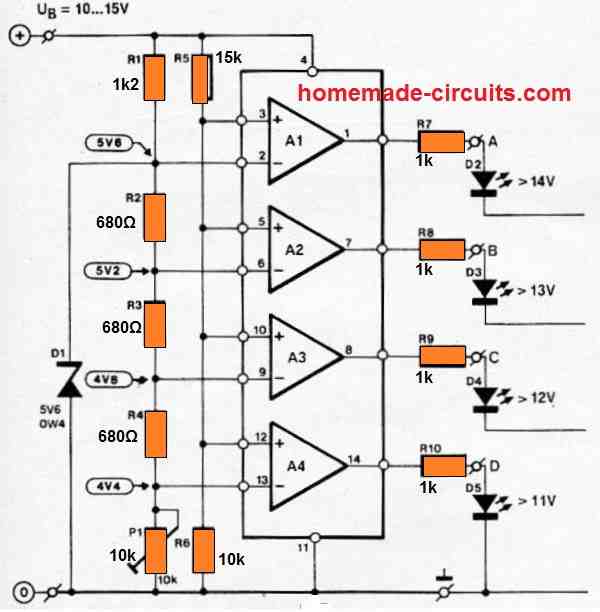
How it Works
The LED voltmeter discussed is generally used to track the charging and discharging of a vehicle battery. Because of its tiny size, it may be placed almost anywhere on the dashboard. The device is based on a low-cost quad opamp Type LM324, which may be powered directly from the automobile battery.
A comparison of the battery voltage and a reference voltage from each of the four opamp inputs generates the voltage readout. The reference voltage is generated using a zener diode connected to a bias resistor R1 and allowing a current of roughly 6 mA. 5V6 was chosen as the zener voltage because zener diodes running between 5 and 6 V have the highest thermal stability.
ALL THE LED CATHODES ARE SUPPOSED TO BE CONNECTED TO THE GROUND LINE.
2) Modifying the above 4 status Battery Indicator with Flashing LEDs
The above explained 4 LED battery status indicator can be modified appropriately for enabling it with flashing LED indicators, as shown in the following diagram:
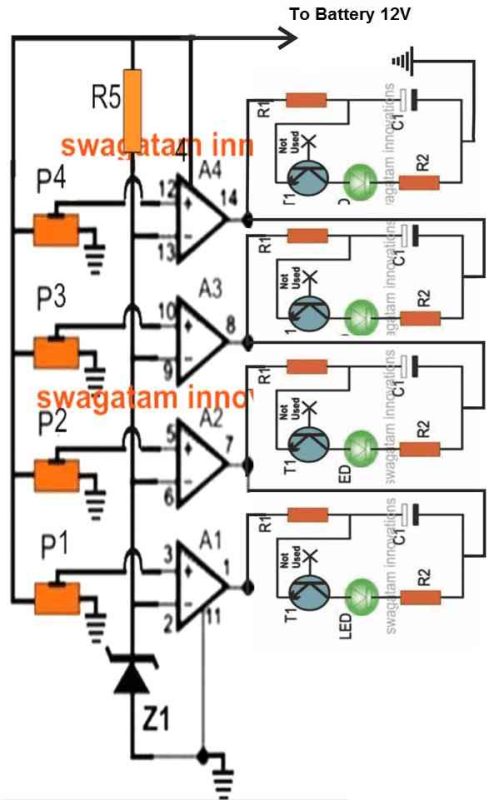
- R1 = 2k2
- R2 = 100 ohms
- LED = 20mA 5mm type
- C1 = 100uF to 470uF depending on flashing rate preference
The article shows a simple method of using the IC LM3915 for monitoring battery voltages right from 1.5V to 24V in 10 discrete steps using 10 LED indicators.
3) Using a LM3915 IC for the 10 Step Function
The third circuit I have explained below allows you to visualize precisely what voltage your battery has at any particular instance while it's being charged.
The LM3915 is basically a 10 stage dot/bar mode LED driver circuit which provides a sequential 10 step LED display corresponding to the varying voltage levels set at its signal input pinout#5.
This input can be set with any voltage level right from 1 to 35V for acquiring a correspondingly sequencing readout of the voltages fed on that pin.
In the proposed 10 step battery charging indicator and monitor circuit we assume the battery to be a 12V which is to be monitored, the circuit functioning may be understood as follows for the aforesaid condition:
The transistor at the right end is configured as an emitter follower replicating a high current, constant voltage zener diode, fixed at 3V.
This is required so that the LEDs are restricted from drawing excessive current, unnecessarily making the IC warm.
The battery voltage is also fed to pin#5 via a voltage divider network made from a 10K resistor and a 10K preset.
The outputs of the IC are all connected with 10 individual LEds for producing the required 10 step indications. The color of the LEDs can be as per your preference.
How to Set up the above explained battery status indicator Circuit.
- It's pretty simple.
- Apply the full-charge voltage level across the point indicated "to battery positive" and ground.
- Now adjust the preset such that the last LED just illuminates at that voltage level.
- Done! Your circuit is all set now.
- For calibrating, simply divide the above mentioned full charge level with 10.
- For the present case, let's assume the full charge level to be 15V, then 15/10 = 1.5V, meaning each LED would stand for an increment of 1.5V. For example with the 8th LED just ON would indicate 1.5 x 7 = 10.5V, 8th LED = 12V, 9th LED = 13.5V and so on.
- Similarly, the circuit can be used with any battery and just needs to be set as per the above guidelines for achieving the proposed 10 step battery level monitoring.
Circuit Diagram

Precision Car Battery Monitor Circuit
An accurate automobile battery monitor circuit is shown in the following image.
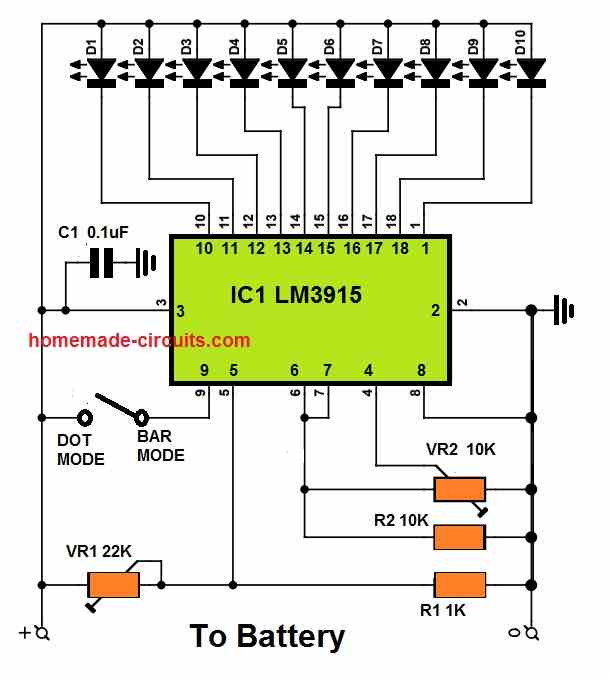
It only includes the IC LM3914 and 10 LEDs, along with some resistors. With VR2, you may choose the lowest limit of the measurement range at which the scale's first LED (D10) will illuminate.
Using VR1, a maximum battery voltage range is determined.
The scale's LEDs each indicate a tenth of the total measurement range. There won't be any LED illuminated if the voltage stays below the lower limit. D1 would stay illuminated if the voltage exceeds the upper limit.
How to Set Up
Practically any required measurement range may be specified using VR1 and VR2. As an illustration, let us consider an automobile battery whose level needs to be monitored.
Setting the top limit with VR1 to, say, 15 V is suitable given that the charging voltage is normally about 14.4 V. It is simple to do this by briefly connecting the circuit to a 15 V variable power supply source and rotating VR1 until D1 illuminates.
VR2 must be fully rotated clockwise throughout this adjustment process to avoid any adverse effects. The voltage that the lowest LED should display is what we need to figure out next.
For example, if we wanted each LED incrementing by 0.5V, the illumination sequence would be 15V, 14.5V, 14V, 13.5V, 13V, 12.5V, 12V, 11.5, 11V, and 10.5V.
The variable power supply source is now adjusted at 10.5V, and VR2 is tweaked until the lowest LED lights up.
Finished, that's all!
Don't forget that smaller increments of 0.33V or 0.25V as well as bigger increments of 1 V can be also made in the identical manner.
Begin by completely rotating VR2 clockwise, then tweak the upper voltage using VR1, then decrease voltage using VR2.
You'll see that the LEDs switch on and off gradually with very little increments, like 1/10 V, thus it may be feasible that two LEDs are illuminated simultaneously at a specific voltage level.
Dot Mode or Bar Mode
Both dot-mode and bar-mode may be used with the IC LM3914 or LM3915. Only one LED at a time will be illuminated in the first scenario. In the second situation, all of the relevant LEDs will be switched on depending the corresponding level of the voltage.
Pin 9 of the IC is used to switch between the two different modes. If it is left open, the IC will work in dot-mode. Bar mode is triggered once the switch is closed.
Car Battery Voltage Monitor Circuit
The first concept above can be also modified as a 4 LED car voltmeter which will allow us to monitor the voltage level of the battery of our car at any instant, continuously.
Main Features
To achieve the above feature it must be placed somewhere in the dash of the car so that the group of 4 LEDs remain protruded, each with a label indicating the battery voltage having at that instant.The circuit is designed for executing the following:
- 1st LED lights with 11V battery
- 1st and 2nd LEDs light with battery 12V
- 1st, 2nd and 3rd LEDs light with battery 13V
- 1st, 2nd, 3rd and 4th (all) LEDs light with battery 14V
Operational Details
When the battery voltage drops to 11 or 12 volts, it may need charging. If its around 13 volts it is in acceptable condition. At 14 volts it is fully charged. The colors of the LEDs indicate these status.
The main components of the circuit are just a few operational amplifiers used as comparators.
The inverting inputs of these operational are set at fixed reference voltages using resistor R1, and a zener diode D1 that may be rated at 3.3V or more, but below 6V.
The non-inverting inputs of the op amps are adjusted using the resistors R2, R3, R4, R5, R6. These may be calculated fixed resistors, or these may be replaced with 1 K presets so that the desired adjustment can be implemented for turning ON the LED at the respective battery voltages.
The battery voltage is delivered to non-inverting inputs of the opamps through the shown voltage divider networks formed by R4 and R6 terminals.
Depending on the battery voltage, the voltage at the non-inverting terminal will vary and will put a high voltage level at the output of the comparator, activating the corresponding LED for the required indications.
Circuit Diagram
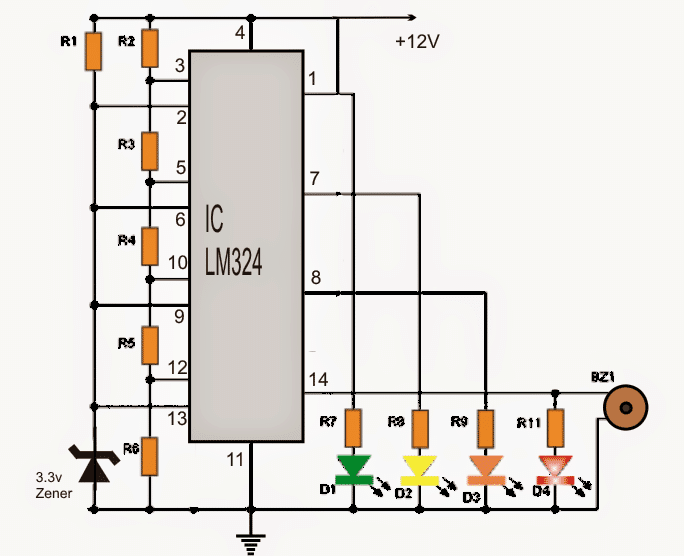
Parts list for the circuit
- IC1: LM324 integrated (quad opamps in a single integrated) Circuit
- D1: 3.3V zener diode, 1/4 watt
- D2 = D3 = D4 = D5: Diodes LED (2 red, 1 yellow or amber, 1 green)
- R1 = 1K
- R2.....R6: all 1K preset
+12V: is the car battery whose voltage is to be sensed
Another simple 4 LED battery monitor circuit is shown in the following image, using the IC LM324:
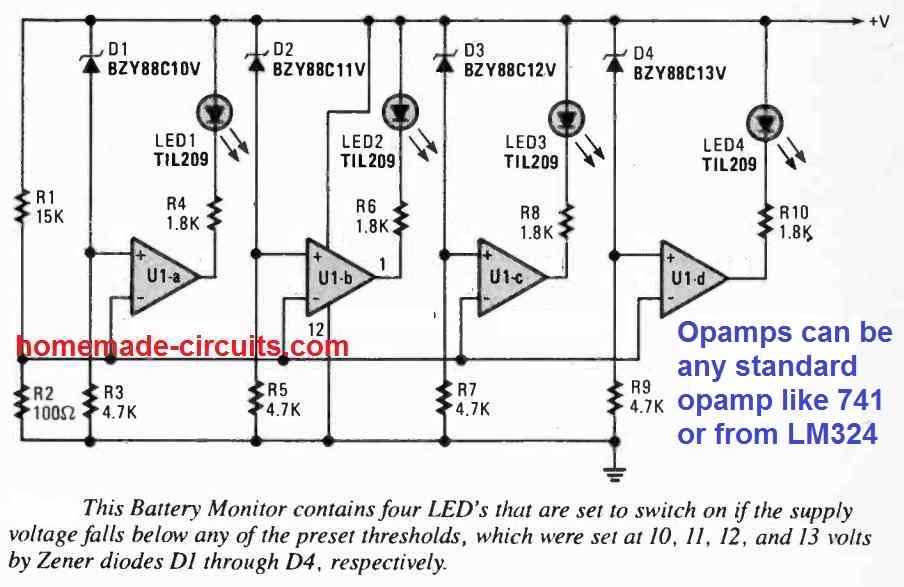
Miscellaneous Easy Battery Monitor Circuits
The first circuit is an battery over voltage indication circuit that replaces the IC-based design with a single transistor. The base of transistor Q1 is coupled to the preset potentiometer, R4, while the emitter of transistor Q1 is hooked up to a 6 volt Zener reference.
No collector current is able to flow and the indicator LED1 remains shut off as long as the voltage at the base of Q1 is less than 6.6 volts. Q1 switches on and lights the LED if the base voltage rises over this value. R4 can be adjusted to enable the circuit to detect and monitor the desired voltage level.
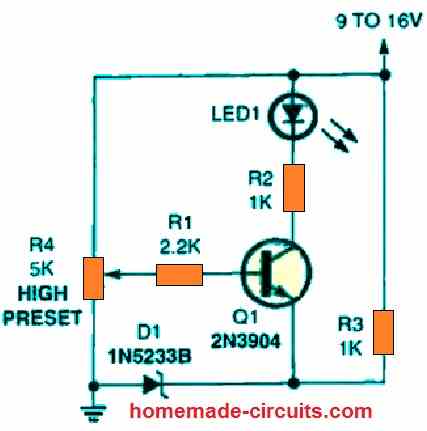
In the following circuit, we add a second transistor to our previous circuit, converting it from an over-voltage to an under-voltage battery warning circuit.
This is how it goes.
Firstly, potentiometer R6 is set to switch transistor Q1 off at the desired low-voltage limit. When Q1 is switched off, the collector voltage rises, providing a positive bias for the base of transistor Q2.
This bias activates Q2 and illuminates LED1. Transistor Q1 is turned back on when the supply voltage returns to normal, this situation now forces transistor Q2 and the LED to switch OFF.
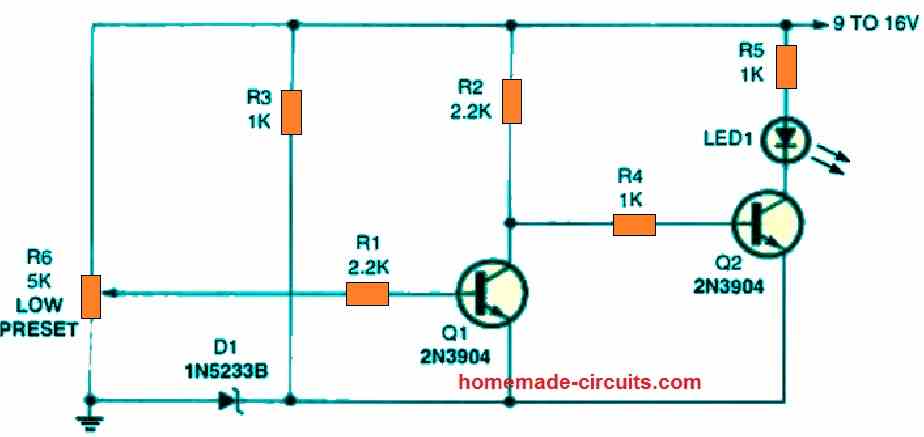
One portion of an LM339 quad voltage comparator IC is used at the center of the this battery monitoring circuit. The negative input voltage of the comparator is fixed by a 6 volt Zener diode reference, while the positive input of the IC is adjustable.
The output at pin 2 of the IC would be high as long as the voltage at the comparator's positive input is higher than the voltage at its negative input, leaving the LED switched OFF and the buzzer silent.
The comparator's output turns low the moment these input parameters are inverted, illuminating the LED and activating the piezo device.
Find the low voltage threshold and tweak potentiometer R3 to provide an output at this voltage level while building this circuit. R3 can be adjusted with just about any 4k7 potentiometer, however a multi-turn trimming potentiometer enables the tuning to be considerably simpler.
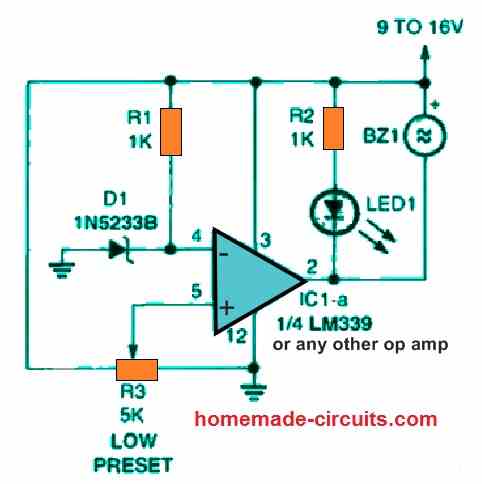
When the supply voltage exceeds a predefined level, this below given circuit generates a signal. The circuit is identical to the previous design except that the comparator's inputs have been inverted.
The output is kept high as long as the voltage at the comparator's negative input is lower than the voltage at the comparator's positive input.
The comparator's output becomes low when this situation is reversed, illuminating the LED and activating the piezo device. This battery over-voltage indication circuit could be a perfect match for any valuable type of hardware that works with a chargeable battery from an AC-operated source.

The first two op amp circuits are joined in the following figure to form a double voltage-monitoring circuitry. Whenever the supply voltage being checked is well within its predetermined limits, the LEDs in this circuit illuminate. IC1-a's circuitry is tuned to monitor the low-voltage level, whereas IC1-b's circuitry maintains track of the maximum voltage limit.
When the measured battery voltage falls below the lower threshold, the setting of potentiometer R3 turns off LED1, and when the voltage rises over the higher limit, the setting of potentiometer R4 turns off LED2.
Contrary to our previous two op amp circuits, the reference supply voltage Zener could be seen replaced by a single 78L05 IC 5 volt regulator. However, in this battery high/low dual voltage monitor circuit, a single Zener would also work instead of the 78L05 IC.
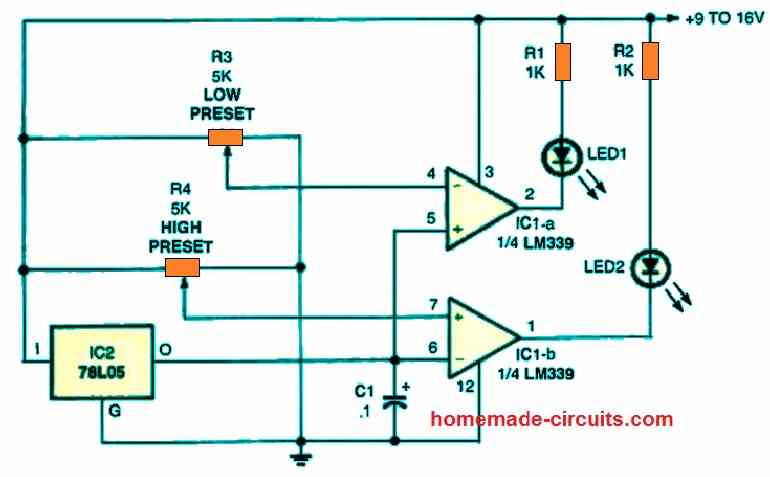


With over 50,000 comments answered so far, this is the only electronics website dedicated to solving all your circuit-related problems. If you’re stuck on a circuit, please leave your question in the comment box, and I will try to solve it ASAP!